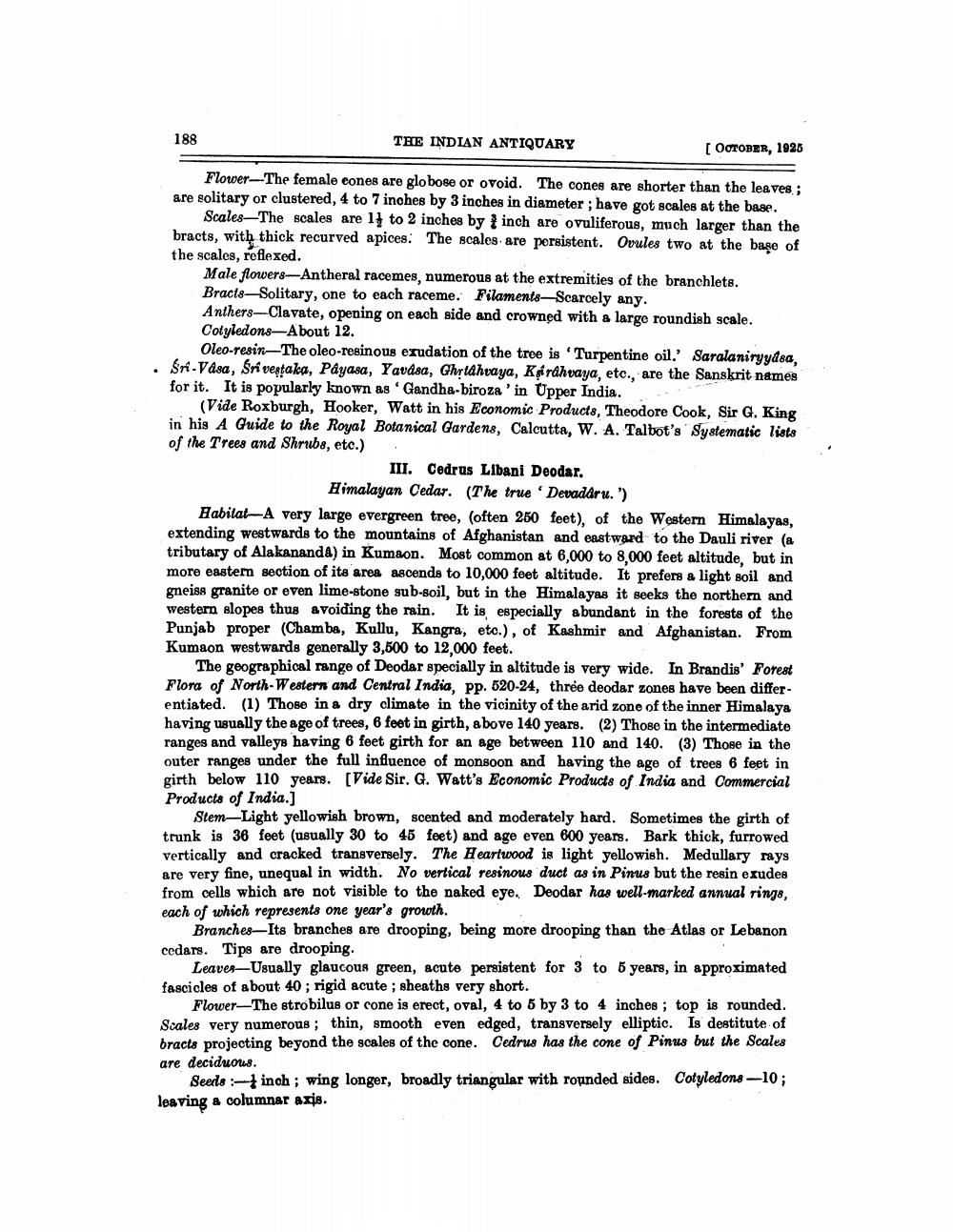________________
188
THE INDIAN ANTIQUARY
[OCTOBER, 1925
Flower-The female cones are globose or ovoid. The cones are shorter than the leaves ; are solitary or clustered, 4 to 7 inches by 3 inches in diameter; have got scales at the base.
Scales—The scales are 11 to 2 inches by inch are ovuliferous, much larger than the bracts, with thick recurved apices. The scales are persistent. Ovules two at the base of the scales, reflexed.
Male flowers-Antheral racemes, numerous at the extremities of the branchlets. Bracts-Solitary, one to each raceme. Filaments-Scarcely any. Anthers---Clavate, opening on each side and crowned with a large roundish scale. Cotyledons-About 12.
Oleo-resin-The oleo-resinous exudation of the tree is 'Turpentine oil.' Saralaniryydsa, Sri. Vasa, Sri vestaka, Payasa, Yavdsa, Ghrtahraya, Kiráhraya, etc., are the Sanskrit names for it. It is popularly known as 'Gandha- biroza ' in Upper India.
(Vide Roxburgh, Hooker, Watt in his Economic Products, Theodore Cook, Sir G, King in his A Guide to the Royal Botanical Gardens, Calcutta, W. A. Talbot's Systematic lists of the Trees and Shrubs, etc.)
III. Cedrus Libani Deodar.
Himalayan Cedar. (The true Devadaru.') Habitat-A very large evergreen tree, (often 250 feet). of the Western Himalayas, extending westwards to the mountains of Afghanistan and eastward to the Dauli river (a tributary of Alakananda) in Kumaon. Most common at 6,000 to 8,000 feet altitude, but in more eastem section of its area ascends to 10,000 feet altitude. It prefers a light soil and gneiss granite or even lime-stone sub-soil, but in the Himalayas it seeks the northern and western slopes thus avoiding the rain. It is especially abundant in the forests of the Punjab proper (Chamba, Kullu, Kangra, etc.), of Kashmir and Afghanistan. From Kumaon westwards generally 3,500 to 12,000 feet.
The geographical range of Deodar specially in altitude is very wide. In Brandis' Forest Flora of North-Western and Central India, pp. 620-24, three deodar zones have been differentiated. (1) Those in a dry climate in the vicinity of the arid zone of the inner Himalaya having usually the age of trees, 6 feet in girth, above 140 years. (2) Those in the intermediate ranges and valleys having 6 feet girth for an age between 110 and 140. (3) Those in the outer ranges under the full influence of monsoon and having the age of trees 6 feet in girth below 110 years. (Vide Sir. G. Watt's Economic Products of India and Commercial Products of India.)
Stem-Light yellowish brown, scented and moderately hard. Sometimes the girth of trunk is 36 feet (usually 30 to 45 feet) and age even 600 years. Bark thick, furrowed vertically and cracked transversely. The Heartwood is light yellowish. Medullary rays are very fine, unequal in width. No vertical resinous duct as in Pinus but the resin exudes from cells which are not visible to the naked eye. Deodar has well-marked annual ringe, each of which represents one year's growth.
Branches-Its branches are drooping, being more drooping than the Atlas or Lebanon cedars. Tips are drooping.
Leaver-Usually glaucous green, acute persistent for 3 to 5 years, in approximated fascicles of about 40 ; rigid acute; sheaths very short.
Flower-The strobilus or cone is erect, oval, 4 to 5 by 3 to 4 inches ; top is rounded. Scales very numerous ; thin, smooth even edged, transversely elliptic. Is destitute of bracts projecting beyond the scales of the cone. Cedrus has the cone of Pinus but the Scales are deciduous.
Seeds - inch ; wing longer, broadly triangular with rounded sides. Cotyledons-10; leaving a columnar axis.




